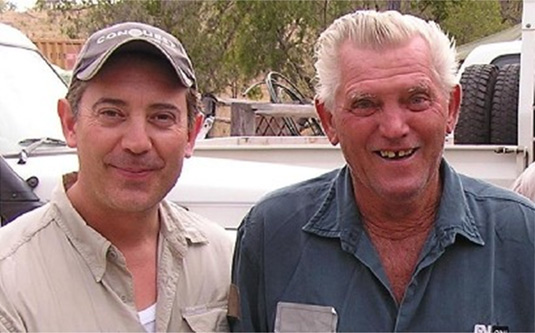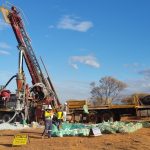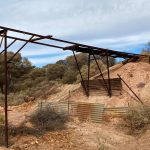The Project is located in northern Queensland, approximately 130 kilometres southeast of the city of Townsville. Work since 2019 has delineated 29 individual target areas prospective for high and low sulphidation epithermal style gold-silver mineralisation, porphyry hosted gold-copper mineralisation and intrusion related gold (IRG) mineralisation. A subsequent ranking exercise, incorporating “ground truthing”, has defined a sub-group of higher priority target areas, namely Molongle, Mt Dillon, Red Rocks, Leichhardt Creek and Sledgehammer. The licences comprising the Edinburgh Park Project surround and abut the ~1.7Moz gold equivalent Mt Carlton gold-silver-copper mine, currently owned by Navarre Minerals (ASX:NML).

Of the 29 targets defined to date, a ranking exercise has defined five high priority target areas which are detailed below.
Molongle (high sulphidation epithermal gold-silver target)
Molongle is north-south trending ~700m x 150m zone of epithermal-style quartz veined hydrothermal breccia within a silica-sericite-pyrite altered dacite porphyry. Surface soil geochemistry has shown the breccia is strongly anomalous in gold, silver, lead, antimony and arsenic, with surface rock chips grading up to 5.3g/t gold. Just 11 reverse circulation (RC) holes have been drilled into the target area historically with the majority being shallow, vertical and predate 1990. Refer to the ASX announcement of 29 June 2023 for more details.
Historical drilling targeted induced polarization (IP) anomalies, with limited success in hitting their targets. Based on magnetic surveys and surface mapping, GSN believes that mineralisation is more likely to be controlled by prominent northwest and northeast trending structures, which will be the target for future drilling. Additionally, the Molongle breccia is underlain by a ~800m x 400m untested resistive IP anomaly at approximately 150m depth, which represents a clear drill target. Several shallower (~100m depth) conductive IP targets also remain untested.
Mt Dillon (high sulphidation epithermal gold-silver target or porphyry system)
Mount Dillon is directly northeast of Molongle and interpreted to be part of the same sequence of volcanic rocks, albeit over a larger surface area (~2.5km by 1.5km) and extending over a greater thickness, based on topography. The entire Mount Dillon area is affected by strong clay-pyrite-silica alteration, with an abundance of sulphide typically varying from 3% to 10%. The widespread distribution of pyrophyllite and argillic alteration at Mount Dillon implies the presence of a relatively high temperature (>300ºC), acidic hydrothermal system, typical of a high-sulfidation epithermal environment. Despite the pervasive alteration observed, rock chip geochemistry for metals and pathfinder elements is generally low. The features of Mount Dillon are consistent with a lithocap or outflow zone of a significant porphyry mineral system.
Red Rock (porphyry copper-gold-silver-molybdenum target)
The Red Rock target is exposed by Molongle Creek between Molongle and Mt Dillon prospects and named after the prominent red hematite-potassium feldspar alteration in the area. This alteration and its lower topography is considered to be an indication of a lower position within a porphyry system. This is hypothetically closer to the potassic core, and therefore potentially closer to porphyry gold-copper mineralisation. GSN has collected rock chip samples from the area grading up to 0.54% copper and 63 g/t silver.
Leichhardt Creek
Leichhardt Creek extends over an area of approximately seven kilometres. It contains granophyric and porphyritic granites intruding into the regional basement Carboniferous granitoids, relating to a late-stage deformation event (D4). The area shows clear porphyry-style zonation of alteration and trace elements, incorporating a high temperature, molybdenum rich potassic core, an intermediate phyllic zone with elevated base and precious metals and distal propylitic alteration with lesser metal enrichment.
There are several areas of interest within Leichhardt Creek, including a 3km by 1km stockwork zone containing sheeted veins with quartz-pyrite infill, gossanous breccia pipes (Rocky Ponds and North Breccias) and gold-bearing stockwork veining (Megan Veins). The southwest portion of Leichhardt Creek contains surface base and precious metal enrichment largely associated with phyllic alteration.
Sledgehammer (Shear hosted and/or epithermal gold-silver target)
The Sledgehammer target is located 18km south of the Mt Carlton mine, hosted in a sequence of basalts and volcaniclastic rocks. The area is largely under cover, however some surface geochemical sampling of outcropping quartz-pyrite veining and brecciation has yielded bonanza grades of up to 47.5 g/t gold and 38.2 g/t silver. Refer to ASX announcement 29 July 2014. The area is also anomalous in arsenic, copper and molybdenum.
Paul Szabo 1939 – 2014

Paul Szabo was instrumental in the discovery of the Mt Carlton/Silver Hill gold and silver deposit in 2006, and continued to be a valuable member of the Conquest and Forte (now GSN) team until health problems forced his retirement in 2013.
He had an incredible depth of knowledge built up from decades of real world experience in the field in north Queensland. Paul’s passion for his work, his brutal honesty and loyalty will long be remembered.




